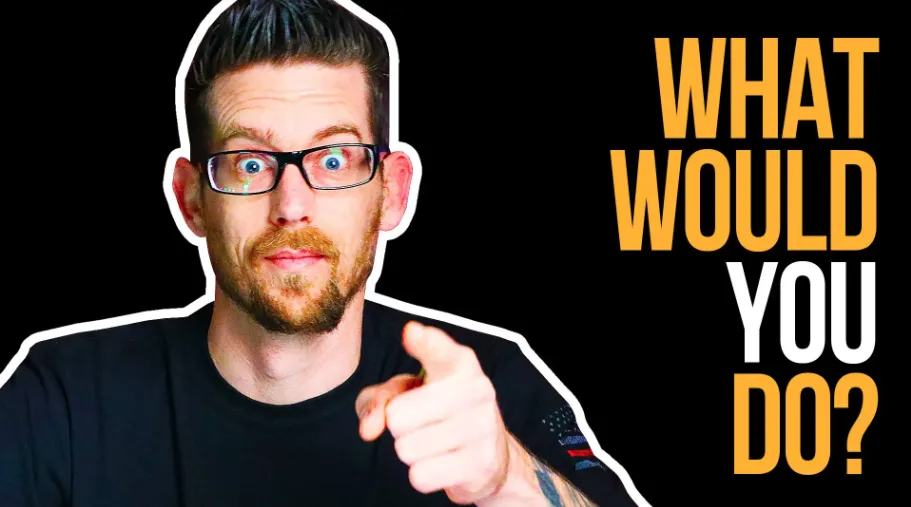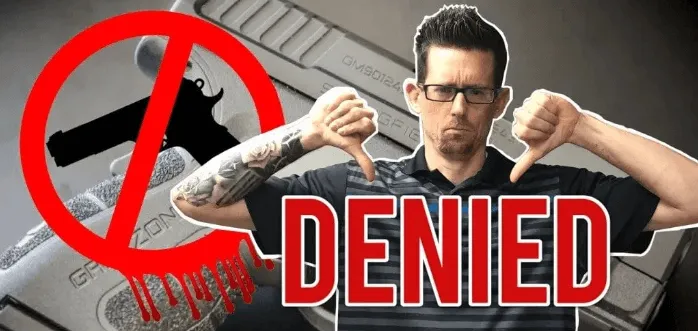Florida Concealed Carry Law Blog
Follow Us for News, Tips , Tricks, Guns Gear and Real Life Stories

How To Play The "What Would I Do If Game"?
What's Up Sheepdogs? Ryan here with Tampa Carry.
During my courses, I will frequently pose a scenario to the group and ask them to tell me the best course of action that is authorized by law. After a few minutes of discussing all of the different factors a person must consider before pressing the trigger, someone will eventually say, “How am I supposed to think about all of this information while I'm being attacked?” My response is, “You can't. It's not possible. Instead, you have to think about all of this information weeks, months, and years before the violent attack ever occurs by playing the ’What would I do if’ game.”
I first learned about this game from a police officer. He told me that every time he would approach a vehicle, he would think to himself, “What would I do if this person pulled a gun?” Then he would review the different ways he could gain a strategic advantage over the driver to win the fight. One of the strategic advantages was increasing the difficulty for the driver to make an accurate hit by standing behind the driver during the traffic stop. I was intrigued by this, so I asked, “How else do you play this game?”
Every time I enter a building, I think, “What would I do if this store was robbed while I was inside?” Then I run through each possible option I would have to respond and the pros and cons of each. Over time, I'm able to develop shortcuts in my brain for how I would respond in different scenarios.
The ‘What Would I Do If’ Game
The purpose of the “What would I do if” game is to force you to think about the best course of action to take during a life-or-death situation. However, it's a lot more complex than, “Are you going to shoot or not?” Instead, the “What would I do if” game involves you looking at your everyday life and determining the types of threats that you are most likely to encounter.
Here's an example:
A young female college student may be concerned about being attacked while walking through a dark parking lot after class.
A parent may be concerned about their child being abducted while grocery shopping.
A woman may be concerned about being the victim of rape.
A man may be concerned about being robbed by multiple attackers.
After you identify a potential future threat, you should begin asking yourself the following questions:
How could this situation be avoided?
What level of force can I legally use in this situation?
Does this scenario fall under the castle doctrine statute?
Does this scenario fall under the justified use of force statute?
Where is my line in the sand?
What am I going to do if placed in this situation?
In the following section, we will discuss each of these six questions and how they will affect your decision-making process as you prepare for the worst day of your life.
Question #1
How Could This Situation Be Avoided?Our primary goal is to identify a potentially dangerous situation and avoid it at all costs. The only way you would ever be able to avoid a violent situation is if you are aware of a potentially dangerous situation before it begins. The only way to accomplish this is with situational and intuitive awareness.
Situational awareness is the art of achieving 360-degree awareness of your surroundings at all times. It sounds simple enough, but the vast majority of Americans don't have a clue what is happening around them. Recently I was walking in a store and noticed a young woman walking toward me. This woman walked for about 50 feet with earbuds in, staring at her phone. Not once did she look up to see who was around her. She was a sheep, utterly oblivious to the world around her, and she is exactly what the wolves are looking for.Situational awareness can be broken into three separate parts: visual awareness, auditory awareness, and keeping your head on a swivel.
Visual awareness is the process of watching what is happening around you and asking yourself the following questions:
What would I expect to see in this environment?
What do I see that I was not expecting to see?
What was I expecting to see that I don’t see?
Who is walking close to me?
What type of behavior do I expect to see from other people?
Where is the nearest emergency exit?
What in this area could be used as cover or concealment from a shooter?
Many years ago, I was shopping in a grocery store in Tampa, FL, when I noticed two of the employees placing large display cases near an emergency exit. It didn’t make any sense to me — why would they want to block off an emergency exit? Then, all of a sudden, I noticed a teenager running through the store holding a case of beer. This would-be thief was shocked when he rounded the corner and noticed that the emergency exit he was planning to use to make his great escape had been blocked. This young man dropped the case of beer and ran toward the front of the store in a desperate attempt to evade capture.
This story is a perfect example of how visual clues can make you aware that something strange is happening.
Auditory awareness is the process of listening to the sounds in your environment and asking yourself the following questions:
What sounds do I expect to hear?
What sounds do I hear that I was not expecting to hear?
What was I expecting to hear that I don’t?
If you walked into a business and immediately heard someone yelling, crying, or begging for help, your level of awareness should immediately increase as you observe the area and begin making decisions about your next actions.
Every time I walk into a building, I listen intently to see if I hear anything that I don’t expect to hear.
The final component of situational awareness is keeping your head on a swivel. This is the process of looking around in order to maintain a 360-degree awareness of your surroundings. One day I walked into a UPS store in Brandon, FL. The store was busy with about 10 people in the building. When I opened the door, not a single person looked at me. These people were so involved in preparing their packages, talking to agents, and looking at their phones that they were completely unaware of who I was or if I was a threat. Meanwhile, my head is constantly moving back and forth as I scan my environment for potential threats. Before I walk into a building, I look through the windows to see if the people inside are behaving according to my baseline. While inside, I try to keep my body oriented toward the entrance so that it is easy to watch new people entering the building. As I walk through parking lots, my head moves from left to right as I walk, and every four or five steps, I tuck my head down to see if anyone is behind me.
The goal of situational awareness is not to be paranoid; the goal is to identify potential threats and then avoid them. It's kind of like defensive driving, and I'll bet you don't even have to try to be aware in the car. It comes easily because you've been doing it for so many years. In the beginning, you will feel a little weird counting exits, planning escape routes, and looking to see if someone is threat. Eventually, it will become second nature.
What Is Intuitive Awareness?
Intuitive awareness goes beyond the physical environment to analyzing the people in that environment. Have you ever heard someone say that they had a gut feeling about a particular situation? This gut feeling, also called intuition, is not something you’re born with. Instead, intuition is a learned behavior that must be developed over time. As I've been studying this topic over the last decade, I've discovered something fascinating about intuition. People who grew up in dangerous environments are better at identifying the pre-incident behaviors of an attacker. In contrast, people who grew up in safer areas and have never been exposed to dangerous situations have a much harder time identifying them.
Imagine for a moment that you were going to walk into Publix this evening. How many people would you guess are inside of a Publix between 6 and 7 pm? Probably a lot. Is it possible for you to look at each person in the store to determine if they are a threat or not? No, that process would take too long. Instead, you would need to be able to scan a large group of people very quickly and place them into groups. This process is called profiling. Yes, I said it, and before you call me a racist and start protesting my businesses, keep reading.
Our goal is to profile people based on our baseline for what we expect to be normal behavior. Evil people include those of every race, religion, nationality, gender, and age. So these factors are not reliable indicators that a person has ill intent. Instead, we must profile people based on whether they match our baseline for what we expect to be normal behavior.
What is the normal behavior or demeanor you expect for someone shopping at Publix? I would expect most people to be calm and relaxed. If we walk into the produce section, perform a quick scan, and determine that everyone matches our baseline, do we have to continue to watch those people? No, because they’re behaving in a way that matches our baseline. What if you noticed a man who appears angry, upset, or frustrated? Does that match our baseline? No, this is the person you need to be constantly aware of. However, angry or frustrated behavior alone does not tell us that this person is a threat. He could have lost his job, found out his wife is cheating on him, or just had a bad day. So these factors alone don't tell us who is a threat, but they do tell us who we need to analyze further.
Question #2
What Level of Force Can Legally Be Used?As you are analyzing a potentially violent situation, it important that you ask yourself, “What level of force can I legally use in this situation?”
This could include the use of pepper spray, a stun gun, physical force, or even deadly force. As I've mentioned before, your goal should be to use as little force as necessary to keep yourself safe.
Question #3
Does This Scenario Fall Under the Castle Doctrine Statute?
As we discussed in chapter 12, the castle doctrine is a common law doctrine that gives individuals the right to use or threaten to use deadly force if the attacker is entering or attempting to enter a person’s dwelling, residence, or occupied vehicle unlawfully and by force.Florida Statutes 776.013 (3) A person who is attacked in his or her dwelling, residence or vehicle has no duty to retreat and has the right to stand his or her ground and use or threaten to use force, including deadly force, if he or she uses or threatens to use force…
Florida Statutes 776.013 (4) A person who unlawfully and by force enters or attempts to enter a person's dwelling, residence or occupied vehicle is presumed to be doing so with the intent to commit an unlawful act involving force or violence.
To determine if a given scenario falls under the castle doctrine law, ask yourself the following questions:
Is the attacker entering or attempting to enter a dwelling, residence, or occupied vehicle?
Is the attacker entering or attempting to enter unlawfully?
Is the attacker entering or attempting to enter by force?
Is the use of deadly force a reasonable response?
If your answer to all four of these questions is yes, then according to Florida Statute 776.013(4), you would have a legal right to use or threaten to use deadly force.
Question #4 Does This Scenario Fall Under the Justified Use of Force Statute?
Florida’s Justified Use of Force Statute is commonly referred to as the stand your ground law. Here’s what it says:Florida Statutes 776.012 (2) A person is justified in using or threatening to use deadly force if he or she reasonably believes that using or threatening to use such force is necessary to prevent imminent death or great bodily harm to himself or herself or another or to prevent the imminent commission of a forcible felony. A person who uses or threatens to use deadly force in accordance with this subsection does not have a duty to retreat and has the right to stand his or her ground if the person using or threatening to use the deadly force is not engaged in a criminal activity and is in a place where he or she has a right to be.
To determine if a given scenario falls under the Justified Use of Force Statute, ask yourself the following questions:
Do you have a reasonable belief of imminent death?
Do you have a reasonable belief of great bodily harm?
Do you have a reasonable belief of the imminent commission of a forcible felony?
Is the use of deadly force necessary?
Are you in a place where you have a right to be?
Are you engaged in criminal activity?
The Justified Use of Force Statute 776.012(2) grants us the right to use or threaten the use of force if we have a reasonable belief of imminent death, great bodily harm, or to stop the imminent commission of a forcible felony, as long as the use or threatened use of force was necessary, we are not committing a crime, and we are in a place that we have a right to be.
This means you must answer yes to the first five questions and no to the final question.
Question #5
Where Is My Line in the Sand?
As I've mentioned before, our goal is not to use our firearm. Our goal is to identify a threat and avoid it as much as possible. However, the day may come when you will have no other choice but to pull out your pistol and fire. The line in the sand is the point at which you have no other option but to pull out your weapon and use deadly force.Question #6
What Would I Do in This Situation?The final question you must ask yourself as you play the “what would I do if” game is “What would I do in this situation?”
At this point, you have already identified the level of force that you are legally allowed to use. Now it's time for you take action. I call this the application of skill.
The Application of Skill
I train thousands of people every year to not only survive a violent attack, but to dominate. I've noticed that most people have this false belief that they will somehow be able to perform at a level they have never trained or developed their skills for. I believe this mindset comes from action movies, where we typically see a common theme among storylines: An everyday person has something tragic happen to himself or his family and seeks revenge. We then watch as this individual — who has no background in defensive shooting — clearing rooms, kicking open doors, manipulating a firearm, and killing the enemy. Deep down inside, 90% of gun owners think they will be able to perform like this and manipulate their firearm at a high level due to their false belief that they will rise to the occasion.
The term “application of skill” refers to the highest level of expertise you have achieved as a shooter. Unfortunately, humans do not rise to the occasion. We will always fall back to our highest level of training. Those of you who have not taken the time to develop advanced shooting skills will crumble under the pressure. However, your punishment for failing to develop the necessary skills will be far greater than getting laughed at on social media. Your punishment will be spending the rest of your life knowing that a life could have been saved if only you had taken the time to develop the necessary skills to use your firearm during a violent attack.
This is why I developed the Sheepdog Masterclass, the 21 Day Dry Fire Challenge, 99 Live Fire Drills, and 31 Shoot or Don’t Shoot Scenarios. These powerful courses help you develop the skills, muscle memory, and mindset necessary to dominate a violent attack. During a violent attack, we will always begin at a massive disadvantage because it is always faster to act than it is to react. The goal is that your training and preparation will help you to overcome this disadvantage as you apply your skill to stop the threat. However, if you choose to be lazy or bury your head in the sand, you will never be ready for the worst day of your life. As I mentioned before, I know deep down that it is my responsibility to keep my family safe, which is why I train as hard as I do. I hope you will join me in this pursuit of developing our skills by visiting www.TampaCarry.com
Now that you understand how to play the “what would I do if” game, let’s review some shoot or don’t shot scenarios.
That's all I have for today. So until next time keep training and stay safe...
Ryan G. Thomas
P.S. You’re one step away from getting your Florida concealed carry permit….FAST & EASY…
And for a limited time you can watch the concealed carry course online for free... Click here to get started...
Don't Miss a Thing!
Get Notified When We Post a New Article
Most Popular Concealed Carry Articles

Florida Private Gun Sales Rules

Am I Eligible For A Florida Concealed Carry Permit?
Get FREE Access To The Florida Concealed Carry Masterclass™
Join over 60,000 Floridians Who Chose Tampa Carry To Get Their Florida Concealed Carry Permit
All rights Reserved. Copyright 2026 Tampa Carry



